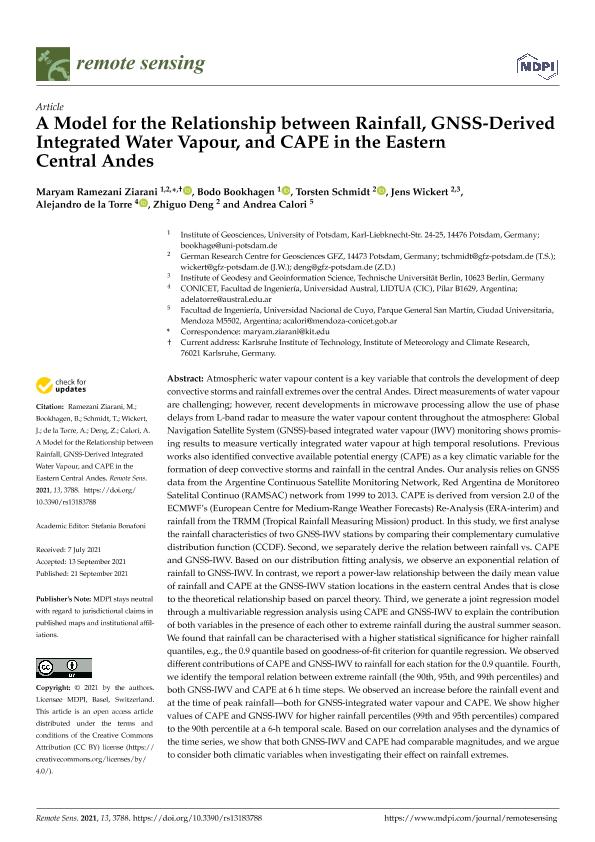Mostrar el registro sencillo del ítem
dc.contributor.author
Ziarani, Maryam Ramezani
dc.contributor.author
Bookhagen, Bodo
dc.contributor.author
Schmidt, Torsten

dc.contributor.author
Wickert, Jens
dc.contributor.author
de la Torre, Alejandro

dc.contributor.author
Deng, Zhiguo
dc.contributor.author
Calori, Andrea Virginia

dc.date.available
2022-04-18T13:38:07Z
dc.date.issued
2021-09
dc.identifier.citation
Ziarani, Maryam Ramezani; Bookhagen, Bodo; Schmidt, Torsten; Wickert, Jens; de la Torre, Alejandro; et al.; A Model for the Relationship between Rainfall, GNSS-Derived Integrated Water Vapour, and CAPE in the Eastern Central Andes; Multidisciplinary Digital Publishing Institute; Remote Sensing; 13; 18; 9-2021; 1-19
dc.identifier.uri
http://hdl.handle.net/11336/155268
dc.description.abstract
Atmospheric water vapour content is a key variable that controls the development of deep convective storms and rainfall extremes over the central Andes. Direct measurements of water vapour are challenging; however, recent developments in microwave processing allow the use of phase delays from L-band radar to measure the water vapour content throughout the atmosphere: Global Navigation Satellite System (GNSS)-based integrated water vapour (IWV) monitoring shows promising results to measure vertically integrated water vapour at high temporal resolutions. Previous works also identified convective available potential energy (CAPE) as a key climatic variable for the formation of deep convective storms and rainfall in the central Andes. Our analysis relies on GNSS data from the Argentine Continuous Satellite Monitoring Network, Red Argentina de Monitoreo Satelital Continuo (RAMSAC) network from 1999 to 2013. CAPE is derived from version 2.0 of the ECMWF’s (European Centre for Medium-Range Weather Forecasts) Re-Analysis (ERA-interim) and rainfall from the TRMM (Tropical Rainfall Measuring Mission) product. In this study, we first analyse the rainfall characteristics of two GNSS-IWV stations by comparing their complementary cumulative distribution function (CCDF). Second, we separately derive the relation between rainfall vs. CAPE and GNSS-IWV. Based on our distribution fitting analysis, we observe an exponential relation of rainfall to GNSS-IWV. In contrast, we report a power-law relationship between the daily mean value of rainfall and CAPE at the GNSS-IWV station locations in the eastern central Andes that is close to the theoretical relationship based on parcel theory. Third, we generate a joint regression model through a multivariable regression analysis using CAPE and GNSS-IWV to explain the contribution of both variables in the presence of each other to extreme rainfall during the austral summer season. We found that rainfall can be characterised with a higher statistical significance for higher rainfall quantiles, e.g., the 0.9 quantile based on goodness-of-fit criterion for quantile regression. We observed different contributions of CAPE and GNSS-IWV to rainfall for each station for the 0.9 quantile. Fourth, we identify the temporal relation between extreme rainfall (the 90th, 95th, and 99th percentiles) and both GNSS-IWV and CAPE at 6 h time steps. We observed an increase before the rainfall event and at the time of peak rainfall—both for GNSS-integrated water vapour and CAPE. We show higher values of CAPE and GNSS-IWV for higher rainfall percentiles (99th and 95th percentiles) compared to the 90th percentile at a 6-h temporal scale. Based on our correlation analyses and the dynamics of the time series, we show that both GNSS-IWV and CAPE had comparable magnitudes, and we argue to consider both climatic variables when investigating their effect on rainfall extremes.
dc.format
application/pdf
dc.language.iso
eng
dc.publisher
Multidisciplinary Digital Publishing Institute
dc.rights
info:eu-repo/semantics/openAccess
dc.rights.uri
https://creativecommons.org/licenses/by/2.5/ar/
dc.subject
CONVECTIVE AVAILABLE POTENTIAL ENERGY (CAPE)
dc.subject
EXTREME RAINFALL
dc.subject
GLOBAL NAVIGATION SATELLITE SYSTEM (GNSS)
dc.subject
GNSS-INTEGRATED WATER VAPOUR
dc.subject
TRMM
dc.subject.classification
Meteorología y Ciencias Atmosféricas

dc.subject.classification
Ciencias de la Tierra y relacionadas con el Medio Ambiente

dc.subject.classification
CIENCIAS NATURALES Y EXACTAS

dc.title
A Model for the Relationship between Rainfall, GNSS-Derived Integrated Water Vapour, and CAPE in the Eastern Central Andes
dc.type
info:eu-repo/semantics/article
dc.type
info:ar-repo/semantics/artículo
dc.type
info:eu-repo/semantics/publishedVersion
dc.date.updated
2022-04-07T20:50:16Z
dc.identifier.eissn
2072-4292
dc.journal.volume
13
dc.journal.number
18
dc.journal.pagination
1-19
dc.journal.pais
Suiza

dc.journal.ciudad
Basilea
dc.description.fil
Fil: Ziarani, Maryam Ramezani. Universitat Potsdam; Alemania. German Research Centre for Geosciences; Alemania
dc.description.fil
Fil: Bookhagen, Bodo. Universitat Potsdam; Alemania
dc.description.fil
Fil: Schmidt, Torsten. German Research Centre for Geosciences; Alemania
dc.description.fil
Fil: Wickert, Jens. German Research Centre for Geosciences; Alemania. Technishe Universitat Berlin; Alemania
dc.description.fil
Fil: de la Torre, Alejandro. Consejo Nacional de Investigaciones Científicas y Técnicas; Argentina. Universidad Austral; Argentina
dc.description.fil
Fil: Deng, Zhiguo. German Research Centre for Geosciences; Alemania
dc.description.fil
Fil: Calori, Andrea Virginia. Consejo Nacional de Investigaciones Científicas y Técnicas; Argentina. Universidad Nacional de Cuyo; Argentina
dc.journal.title
Remote Sensing
dc.relation.alternativeid
info:eu-repo/semantics/altIdentifier/doi/http://dx.doi.org/10.3390/rs13183788
dc.relation.alternativeid
info:eu-repo/semantics/altIdentifier/url/https://www.mdpi.com/2072-4292/13/18/3788
Archivos asociados
